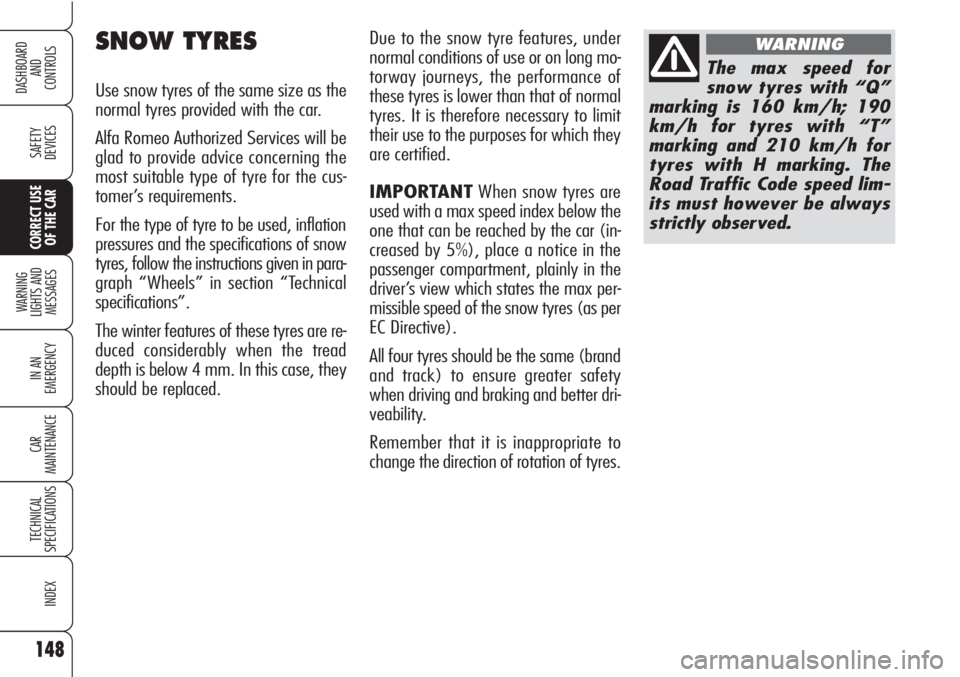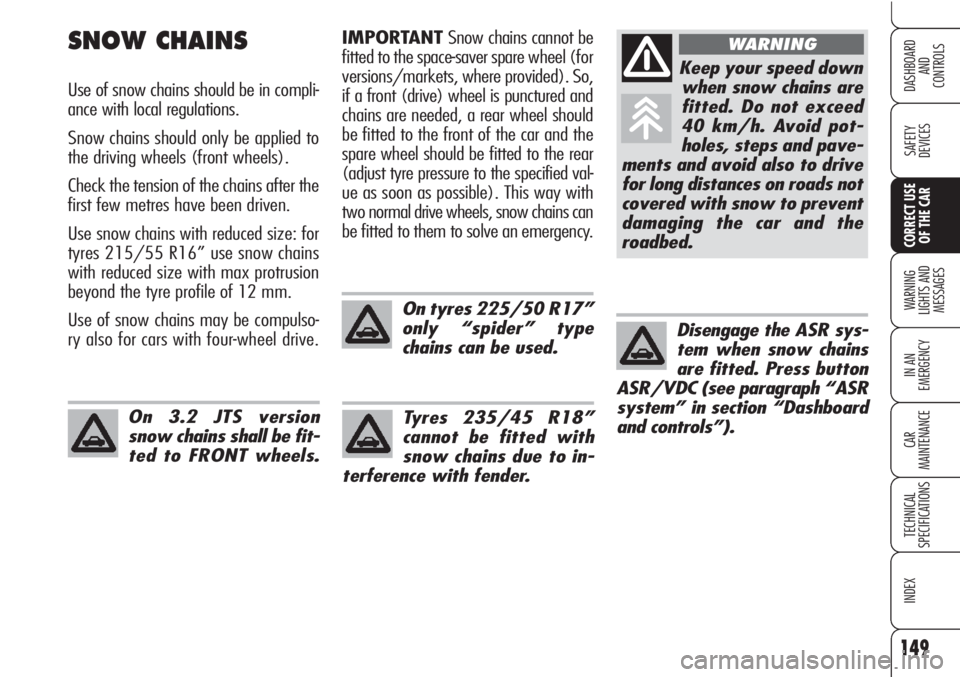2010 Alfa Romeo Brera/Spider four wheel drive
[x] Cancel search: four wheel drivePage 100 of 271

98
SAFETY
DEVICES
WARNING
LIGHTS AND
MESSAGES
IN AN
EMERGENCY
CAR
MAINTENANCE
TECHNICAL
SPECIFICATIONS
INDEX
DASHBOARD
AND
CONTROLS
CORRECT USE
OF THE CARHEADLIGHT AIMING DEVICE
It works with the key fitted into the ig-
nition device and dipped beams on.
When the car is loaded, it slopes back-
wards. This means that the headlight
beam rises. In this case, it is necessary
to return it to the correct position.
In this event, to adjust the headlight
slant use control A-fig. 83aset on the
button control panel near the steering
wheel.
If the car is fitted with bixenon head-
lights, headlight aiming is electronic and
therefore control Ais not present.Control has four positions corresponding
to the loads given below:
❒position0- load: driver / driver +
front passenger;
❒position1- load: driver + 3 pas-
sengers / driver + 3 passengers +
load in the boot (65 kg for 2.2 ver-
sion / 50 kg for 3.2 version);
❒position2- load: driver + load in the
boot (290 kg for 2.2 version / 275
kg for 3.2 version);
❒position3- not to be used.
IMPORTANT Check headlight slant
each time the transported load changes.
FRONT FOG LIGHT
ADJUSTMENT
Contact Alfa Romeo Authorized Services
to have the headlights correctly adjust-
ed.
A0F0226mfig. 83a
HEADLIGHT ADJUSTMENT
ABROAD
The dipped beam headlights are adjust-
ed for circulation in the country in which
the car is marketed. In countries with
opposite circulation, to avoid glaring on-
coming vehicles, proceed as follows:
❒remove headlight cover (see para-
graph “Dipped beam headlights” in
section “In an emergency”);
❒move lever A-fig. 84aside.
A0F0050mfig. 84
Page 150 of 271

148
SAFETY
DEVICES
WARNING
LIGHTS AND
MESSAGES
IN AN
EMERGENCY
CAR
MAINTENANCE
TECHNICAL
SPECIFICATIONS
INDEX
DASHBOARD
AND
CONTROLS
CORRECT USE
OF THE CAR
Due to the snow tyre features, under
normal conditions of use or on long mo-
torway journeys, the performance of
these tyres is lower than that of normal
tyres. It is therefore necessary to limit
their use to the purposes for which they
are certified.
IMPORTANTWhen snow tyres are
used with a max speed index below the
one that can be reached by the car (in-
creased by 5%), place a notice in the
passenger compartment, plainly in the
driver’s view which states the max per-
missible speed of the snow tyres (as per
EC Directive).
All four tyres should be the same (brand
and track) to ensure greater safety
when driving and braking and better dri-
veability.
Remember that it is inappropriate to
change the direction of rotation of tyres.SNOW TYRES
Use snow tyres of the same size as the
normal tyres provided with the car.
Alfa Romeo Authorized Services will be
glad to provide advice concerning the
most suitable type of tyre for the cus-
tomer’s requirements.
For the type of tyre to be used, inflation
pressures and the specifications of snow
tyres, follow the instructions given in para-
graph “Wheels” in section “Technical
specifications”.
The winter features of these tyres are re-
duced considerably when the tread
depth is below 4 mm. In this case, they
should be replaced.
The max speed for
snow tyres with “Q”
marking is 160 km/h; 190
km/h for tyres with “T”
marking and 210 km/h for
tyres with H marking. The
Road Traffic Code speed lim-
its must however be always
strictly observed.
WARNING
Page 151 of 271

149
SAFETY
DEVICES
WARNING
LIGHTS AND
MESSAGES
IN AN
EMERGENCY
CAR
MAINTENANCE
TECHNICAL
SPECIFICATIONS
INDEX
DASHBOARD
AND
CONTROLS
CORRECT USE
OF THE CAR
IMPORTANTSnow chains cannot be
fitted to the space-saver spare wheel (for
versions/markets, where provided). So,
if a front (drive) wheel is punctured and
chains are needed, a rear wheel should
be fitted to the front of the car and the
spare wheel should be fitted to the rear
(adjust tyre pressure to the specified val-
ue as soon as possible). This way with
two normal drive wheels, snow chains can
be fitted to them to solve an emergency.SNOW CHAINS
Use of snow chains should be in compli-
ance with local regulations.
Snow chains should only be applied to
the driving wheels (front wheels).
Check the tension of the chains after the
first few metres have been driven.
Use snow chains with reduced size: for
tyres 215/55 R16” use snow chains
with reduced size with max protrusion
beyond the tyre profile of 12 mm.
Use of snow chains may be compulso-
ry also for cars with four-wheel drive.
On tyres 225/50 R17”
only “spider” type
chains can be used.
Keep your speed down
when snow chains are
fitted. Do not exceed
40 km/h. Avoid pot-
holes, steps and pave-
ments and avoid also to drive
for long distances on roads not
covered with snow to prevent
damaging the car and the
roadbed.
WARNING
Disengage the ASR sys-
tem when snow chains
are fitted. Press button
ASR/VDC (see paragraph “ASR
system” in section “Dashboard
and controls”). Tyres 235/45 R18”
cannot be fitted with
snow chains due to in-
terference with fender. On 3.2 JTS version
snow chains shall be fit-
ted to FRONT wheels.
Page 228 of 271

226
SAFETY
DEVICES
WARNING
LIGHTS AND
MESSAGES
IN AN
EMERGENCY
CAR
MAINTENANCE
TECHNICAL
SPECIFICATIONS
INDEX
DASHBOARD
AND
CONTROLS
CORRECT USE
OF THE CARIncorrect pressure causes abnormal tyre
wearfig. 14:
Anormal pressure: tread evenly worn.
Blow pressure: tread particularly worn
at the edges.
Chigh pressure: tread particularly worn
in the centre.
Tyres must be replaced when the tread
wears down to 1.6 mm. In any case,
comply with the laws in the country
where the car is being driven.
IMPORTANT NOTES
As far as possible, avoid sharp braking
and screech starts, etc. Be careful not to
hit the kerb, potholes or other obstacles
hard. Driving for long stretches over
bumpy roads can damage the tyres.
Periodically check that the tyres have no
cuts in the side wall, abnormal swelling
or irregular tyre wear. If any of these oc-
cur, have the car seen to at Alfa Romeo
Authorized Services.
Avoid overloading the car when travel-
ling: this may cause serious damage to
the wheels and tyres; if a tyre is punc-
tured, stop immediately and change it
to avoid damage to the tyre, the rim,
suspensions and steering system.
WHEELS AND TYRES
Check the pressure of each tyre, includ-
ing the space-saver spare wheel, every
four weeks and before long journeys:
pressure should be checked with the tyre
rested and cold.
For the correct tyre inflation pressure,
see “Wheels” in “Technical specifica-
tions” section.
A0F0120mfig. 14
Page 242 of 271

240
SAFETY
DEVICES
WARNING
LIGHTS AND
MESSAGES
IN AN
EMERGENCY
CAR
MAINTENANCE
TECHNICAL
SPECIFICATIONS
INDEX
DASHBOARD
AND
CONTROLS
CORRECT USE
OF THE CAR
FUEL FEED/IGNITION
1750 TURBO BENZINA - 2.2 JTS - 3.2 JTS 2.0 JTDM- 2.4 JTDM
Fuel feed Direct injection Multijet direct injection, variable geometry
turbosupercharger and intercooler
Modifications or repairs to the fuel feed system that are not carried out properly or do not
take the system’s technical specifications into account can cause malfunctions leading to
the risk of fire.
TRANSMISSION
Gearbox
Clutch
Drive
IMPORTANTIn the event of difficult disengagement, due to significant difference of grip between front and rear axle, do
not insist with heavy accelerations: it is actually more effective an attempt of disengagement at medium slow engine rpm,
with pauses of a few seconds if several attempts are necessary.
1750 TURBO BENZINA - 2.0 JTDM- 2.4 JTDM- 3.2 JTS 4x2
Six forward gears + reverse and
synchronisers for forward speeds
Dry single disk with hydraulic control
Front drive3.2 JTS 4x4
Six forward gears + reverse and
synchronisers for forward
speeds
Dry single disk
with hydraulic control
Four-wheel drive
Page 244 of 271

SPACE-SAVER SPARE WHEEL
Pressed steel rim. Tubeless tyre.
UNDERSTANDING
TYRE MARKING fig. 5
Example: 215/55 R 16 93 V
215= Nominal width (S, distance be-
tween sidewalls in mm).
55= Percentage height/width ratio
(H/S).
R= Radial tyre.
16= Rim diameter in inches. (Ø).
93= Load rating (capacity).
V= Maximum speed index.Load rating (capacity)
60= 250 kg 84= 500 kg
61= 257 kg 85= 515 kg
62= 265 kg 86= 530 kg
63= 272 kg 87= 545 kg
64= 280 kg 88= 560 kg
65= 290 kg 89= 580 kg
66= 300 kg 90= 600 kg
67= 307 kg 91= 615 kg
68= 315 kg 92= 630 kg
69= 325 kg 93= 650 kg
70= 335 kg94= 670 kg
71= 345 kg 95= 690 kg
72= 355 kg 96= 710 kg
73= 365 kg 97= 730 kg
74= 375 kg98= 750 kg
75= 387 kg 99= 775 kg
76= 400 kg 100= 800 kg
77= 412 kg 101= 825 kg
78= 425 kg 102= 850 kg
79
= 437 kg 103= 875 kg
80= 450 kg 104= 900 kg
81= 462 kg 105= 925 kg
82= 475 kg 106= 950 kg
83= 487 kg
WHEELS
RIMS AND TYRES
Alloy rims. Tubeless tyres with radial car-
cass. The homologated tyres are listed
in the Log book.
WARNINGIn the event of discrep-
ancies between the information provid-
ed on this “Owner’s Manual” and the
“Log book”, consider the specifications
shown in the log book only.
On cars fitted with four-wheel drive, all
four tyres should be the same (brand
and track) to prevent damaging the 4-
WD system. The efficiency of the 4-WD
system however, is not jeopardized if
tyres with different wear conditions are
fitted.
Attaining to the prescribed size, to en-
sure safety of the car in movement, it
must be fitted with tyres of the same
make and type on all wheels.
WARNINGDo not use inner tubes
with Tubeless tyres.
242
SAFETY
DEVICES
WARNING
LIGHTS AND
MESSAGES
IN AN
EMERGENCY
CAR
MAINTENANCE
TECHNICAL
SPECIFICATIONS
INDEX
DASHBOARD
AND
CONTROLS
CORRECT USE
OF THE CAR
A0F0186mfig. 5